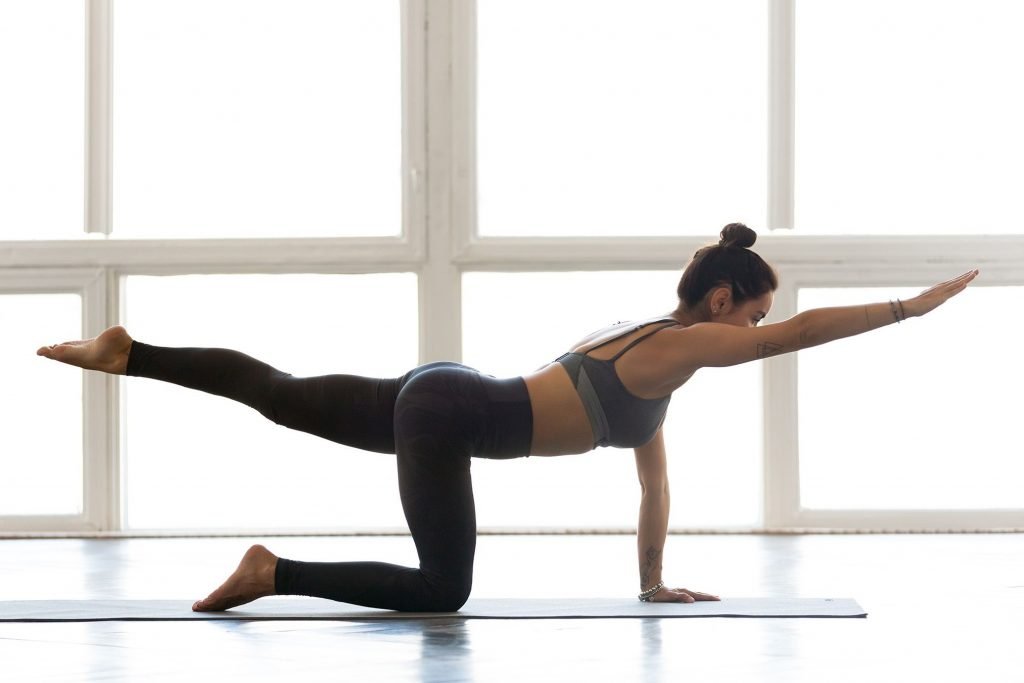The Bird Dog Exercise is a popular core-strengthening movement that also improves balance, stability, and coordination. It’s particularly effective for working the muscles of the lower back, glutes, and abdominal muscles while engaging the shoulders, arms, and legs. It is a functional movement that helps improve posture and can also reduce back pain when performed correctly.

Starting Position:
- Begin on all fours (hands and knees) on a comfortable surface, such as an exercise mat.
- Align your body: Ensure your wrists are directly under your shoulders, and your knees are directly under your hips. Keep your spine neutral (not arched or rounded).
- Engage your core: Draw your navel toward your spine to engage your abdominal muscles. This will help protect your lower back during the movement.
Movement:
- Extend one arm forward: Slowly extend your right arm straight out in front of you at shoulder height. At the same time, extend your left leg straight behind you at hip height. Both limbs should be straight, and you should form a straight line from your fingertips to your toes.
- Hold and squeeze: Hold the extended position for 2–3 seconds, making sure to keep your core engaged and your body stable. Keep your hips level and avoid letting your back arch or your torso twist.
- Return to starting position: Slowly lower your arm and leg back to the starting position without letting your back sag or your hips drop.
- Repeat on the other side: Now, extend your left arm and right leg, and repeat the movement.
- Alternate sides: Continue to alternate between your left and right sides, focusing on maintaining good form throughout.
Tips for Proper Form:
- Neutral spine: Always maintain a neutral spine throughout the movement. Avoid arching your back or allowing your hips to drop.
- Control the movement: Perform the exercise slowly and with control, rather than rushing through it. This ensures you are engaging the right muscles and protecting your back.
- Focus on balance: As you extend your arm and leg, keep your gaze on the floor to help maintain balance and prevent any unnecessary neck strain.
- Breathing: Inhale as you prepare, and exhale as you extend your arm and leg. Maintain steady breathing throughout.
Common Mistakes to Avoid:
- Sagging in the lower back: This can put undue stress on the spine. Engage your core and try to keep your back flat.
- Arching the neck: Keep your neck in a neutral position. Don’t look up or down; keep your gaze on the floor.
- Not engaging the core: Failing to activate your core can lead to poor posture and strain on your lower back.
Benefits of the Bird Dog Exercise:
- Core Strength: The bird dog primarily targets the muscles of the core (abdominals, obliques, lower back) while promoting stability and control.
- Improves Balance and Coordination: The exercise forces you to stabilize your body by using the muscles in your arms and legs, improving overall coordination.
- Spinal Stability: It strengthens the muscles around the spine, which is crucial for preventing back pain and improving posture.
- Posture Enhancement: By strengthening the back and abdominal muscles, the bird dog exercise promotes better posture in daily activities.
- Lower Back Pain Prevention: Regular practice of this exercise can help reduce the risk of lower back pain by improving spinal stability and flexibility.
Modifications:
- Easier version: If you’re new to this exercise or have difficulty balancing, you can perform the bird dog with one arm or one leg at a time, rather than extending both simultaneously. Alternatively, keep the extended limb closer to the ground to reduce the challenge.
- Advanced version: For a more challenging version, you can add a small weight to your hand or ankle to increase the resistance.
How Often to Do the Bird Dog:
You can perform the bird dog exercise daily or incorporate it into your routine 2–3 times a week. Start with 8–10 repetitions per side, and gradually increase the number as you become more comfortable and your strength improves.
* Conclusion *
The Bird Dog Exercise is a simple yet highly effective movement that targets core strength, improves balance, and enhances coordination. It’s a great addition to any workout routine, especially if you’re looking to strengthen your lower back, improve posture, or reduce the risk of back pain. As with any exercise, proper form and control are key to maximizing the benefits and avoiding injury.
